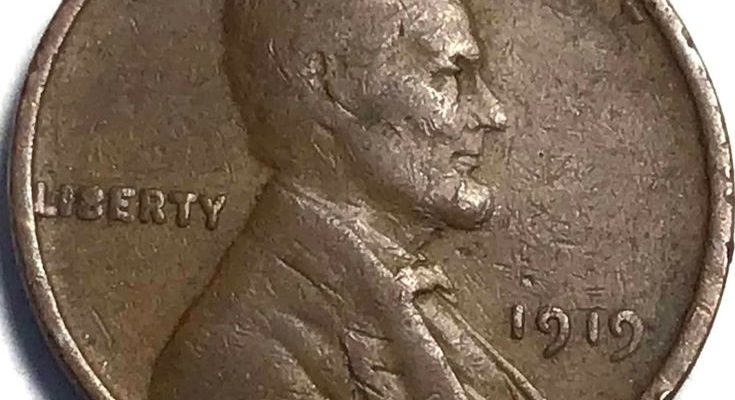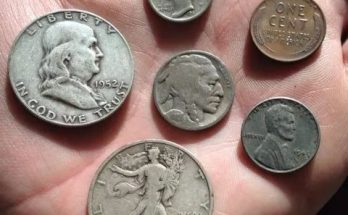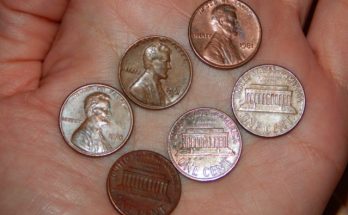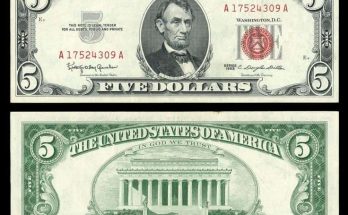One of the first questions regarding the 1919 Wheat Penny is whether it is worth anything. These coins are not made of precious metals, meaning they have little value in terms of metal composition and melt value.
Table of Contents
The 1919 Wheat penny has one of the highest mintage numbers, indicating that there are many of these on the market and they are easily acquired. Those specimens in the average state are not worth big bucks, approximately around $0.40.
However, some rare pieces in the mint state can cost over $100. Let’s check the pennies’ history, value, varieties, and more!
1919 Wheat Penny Details
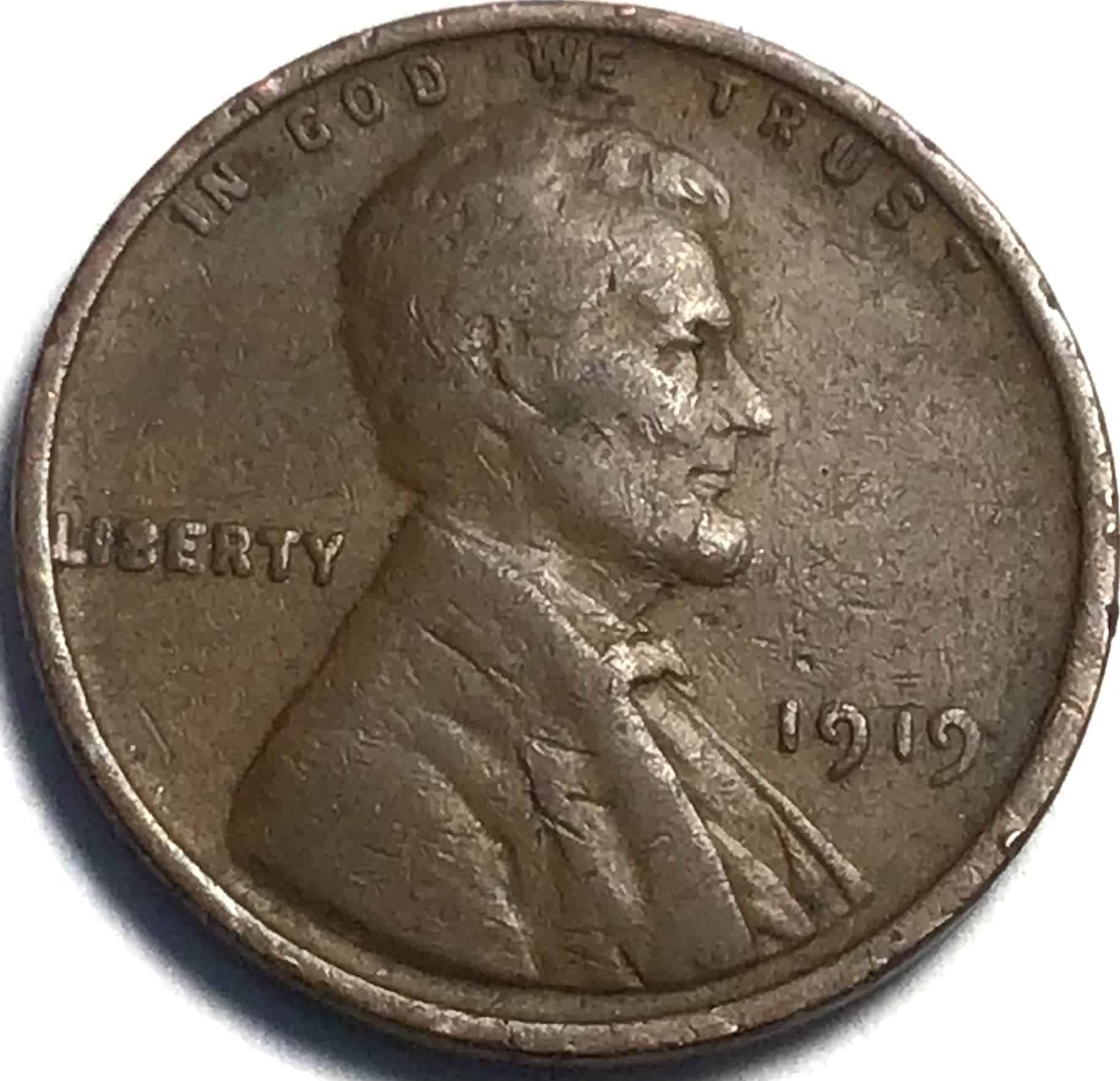
- Mint: Philadelphia, Denver, San Francisco
- Designer: Victor D. Brenner
- Mintage: 588,935,000
- Composition: 95% copper and 5% zinc and tin
- Mass: 3.11 grams (0.1097 ounces)
- Face value: 0.01 (one cent)
- Diameter: 19mm (0.74803 inches)
- Shape: Round
- Edge: Plain
- Category: Wheat Lincoln Penny
The 1919 Wheat Penny was minted at Denver, San Francisco, and Philadelphia facilities. These pennies are unique pieces of American history that have survived important and stressful historical events, such as the Second World War and the Great Depression.
Considering the high mintage number, they are very common, and it is said that every American possesses at least one of these pennies in their house. Considering the metal composition, the pennies are brown colors, although they tend to develop color variations and hues.
These pennies are also known as Lincoln pennies for a simple reason: the obverse features the profile of the famous American president Abraham Lincoln, best known as the 16th president who issued the Emancipation Proclamation in 1863 and freed the enslaved people within the Confederate States.
The image of Abraham Lincoln facing left is in the center of the coin, surrounded by the American motto “In GOD WE TRUST” alongside the upper rim of the coin. On the right side of Lincoln’s image is the date “1919,” while on the left is the inscription “Liberty.”
The engraver’s initials “VDB” can be found on Lincoln’s shoulder. However, the initials are hard to notice, and collectors usually use magnifiers for these details. The 1919 Wheat penny reverse features the denomination “ONE CENT” in the upper part of the coin.
Underneath the denomination is the inscription “UNITED STATES OF AMERICA,” stretched across two rows and surrounded by two wheat stalks, explaining the name of the penny.
Alongside the upper rim of the coin is the other famous American motto, “E PLURIBUS UNUM,” which translates to “Out of many, one.”
The weight of the one-cent 1919 Wheat penny is standard for pennies, which is 3.11 grams or 0.1097 ounces. The metal composition is mostly copper with zinc and tin. The coin’s edge is plain, and the diameter is 19.00mm or approximately 0.74 inches.
1919 Wheat Penny Value Chart |
|||||
| Mint Mark | Good | Fine | Extra Fine | MS 60 | MS 63 |
| 1919 No Mint Mark Wheat Penny Value | $0.40 | $0.50 | $3-$4 | $14-$16 | $30 |
| 1919 D Wheat Penny Value | $0.50 | $1.20 | $10 | $60-$75 | $120 |
| 1919 S Wheat Penny Value | $0.40 | $1.20 | $11 | $50-$65 | $130 |
1919 Wheat Penny Value and Varieties Guide
The 1919 Wheat Penny was produced in San Francisco, Denver, and Philadelphia. The mint mark can be found on the coin’s obverse underneath the date “1919”. The mint mark is usually tiny but easy to find.
If you are a new collector and you came across a 1919 Wheat penny with no mint mark, that does not mean it is fake-the coin was minted in Philadelphia, and generally, every type of coin/penny produced in Philadelphia does not have a mint mark.
The coins minted in Denver have a “D” mint mark, while those produced in San Francisco have an “S” mint mark.
The total mintage of 1919 Wheat Penny is very high, 588,935,000. These pennies are easy to come by and purchase. Many spend a lot of time in circulation, which is usually very visible and can be detected by multiple wears and tears.
Therefore, finding the pieces in mint state is very rare, and their value is much higher. For example, the 1919 Wheat penny with no mint mark costs around $0.20 because most of the pennies are in an average or good state.
Furthermore, Philadelphia had the highest mintage number compared to the other mints, meaning that the 1919 Wheat pennies with no mint mark were the least valuable. The lowest mintage was in Denver, so you can expect to pay more for the 1919 D Wheat Penny.
However, as with all types of coins and pennies, certain factors can significantly change the value of the 1919 Wheat penny.
Error or defect such as double-die and re-punched can boost the value up to $100, which is fascinating considering that the same coin with no mint mark in average condition is worth less than a dollar.
Uncirculated 1919 Wheat penny can cost from $5 to $6 and up to $10 if the penny has an S or D mint mark.
Another critical factor influencing the value of the 1919 Wheat Coin is the color, and the numismatists have established the natural color spectrum for copper pennies. Those are red-brown (RB), red (RD), and brown (BN)
Those with brown and red toning can range from $70 to $12,000. Some specimens with red-brown tone in MS 67 have been sold for a jaw-dropping $36,000.
1919 No Mint Mark Wheat Penny Value
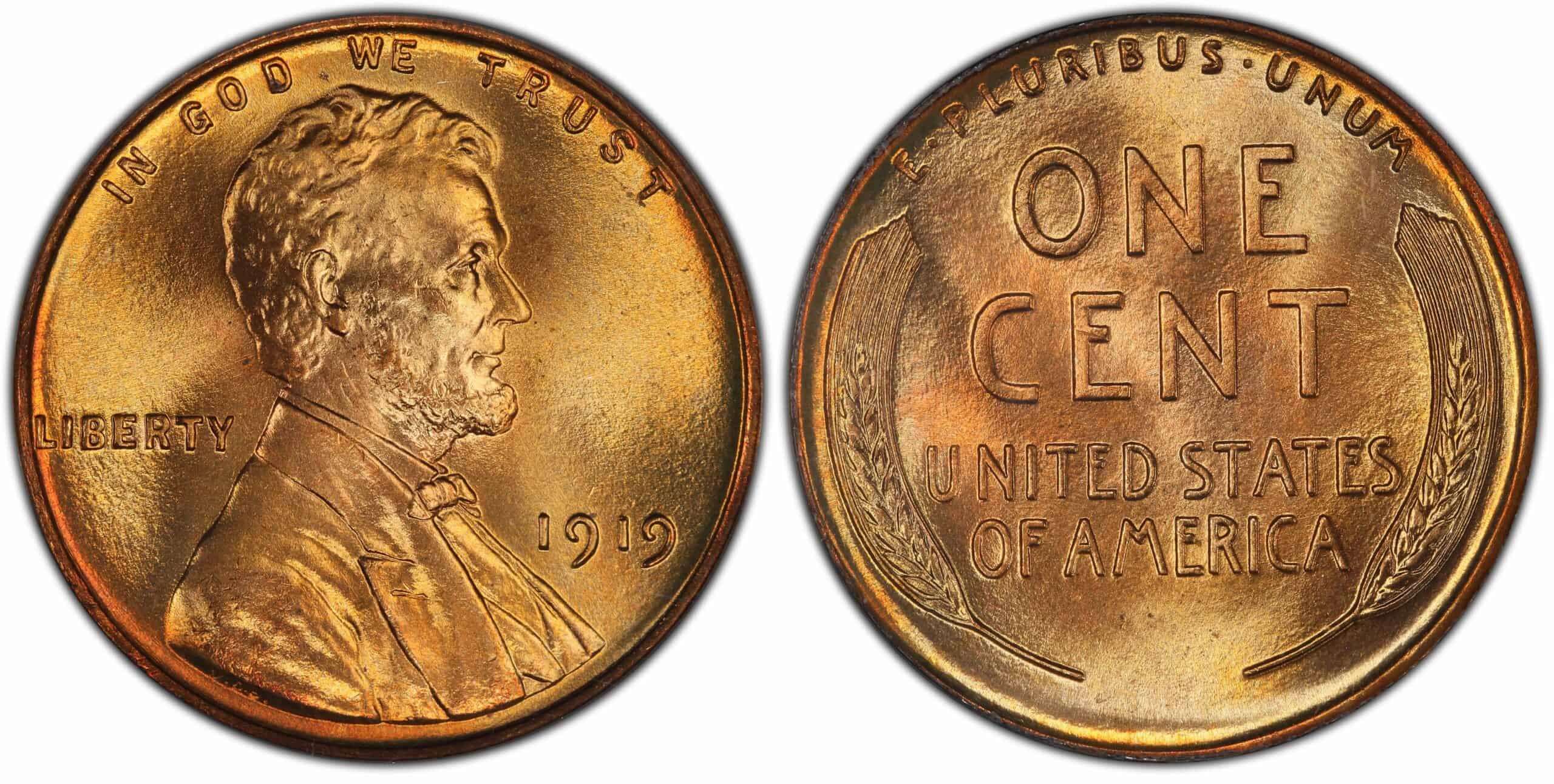
- Mint: Philadelphia
- Designer: Victor D. Brenner
- Mintage: 392,021,000
- Composition: 95% copper and 5% zinc and tin
- Mass: 3.11 grams (0.1097 ounces)
- Face value: 0.01 (one cent)
- Diameter: 19mm (0.74803 inches)
- Shape: Round
- Edge: Plain
- Category: Wheat Lincoln Penny
- Mint Mark: No mint mark
As noted, the Philadelphia had the highest mintage in the series from 1919 to 1933; these coins are not that sought-after, especially in average, good, and fine condition. Even the specimens in mint state, such as MS 65 and MS 67, cost from $7 to $80.
However, the 1919 Wheat pennies with red tones are highly collectible and desirable. For such a piece, you can expect to pay a couple thousand (yes, you read that correctly).
On the other hand, not many pieces with this specific feature are in perfect condition, which explains the price.
Some collectors are willing to pay big bucks for this coin with red toning, ranging from $9,000 to $11,900. The highest amount paid for the 1919 Wheat penny was in 2019- the collector bagged an astonishing $18,000.
1919 “S” Wheat Penny Value
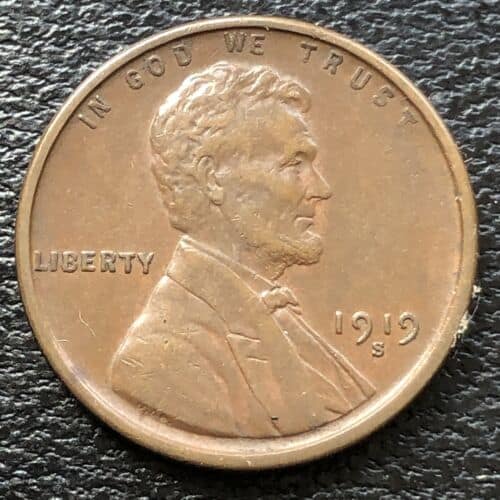
- Mint: San Francisco
- Designer: Victor D. Brenner
- Mintage: 139,760,000
- Composition: 95% copper and 5% zinc and tin
- Mass: 3.11 grams (0.1097 ounces)
- Face value: 0.01 (one cent)
- Diameter: 19mm (0.74803 inches)
- Shape: Round
- Edge: Plain
- Category: Wheat Lincoln Penny
- Mint Mark: S
The San Francisco mint had the second-highest mintage, and these coins are slightly more valuable than those with no mint mark. Considering the mintage, you can find these coins in average and fine condition, but their value is less than a dollar even though they have an S mint mark.
As mentioned, the condition defects and the colors play a significant role in determining the value of the 1919 Lincoln Penny.
For the 1919 S Wheat penny in MS 63 with brown tones, expect to pay from $90 to $110, while those specimens in MS 65 with brown tones can cost $300 to $350. The most expensive is the 1919 Wheat pennies with red tones that are well-struck; in MS 64, they are worth from $610 to $720.
Those in MS 65 can cost from $4,000 to $6,000. The rare specimens with an S mint mark, red color, and in MS 66 can be worth up to $20,000.
1919 “D” Wheat Penny Value
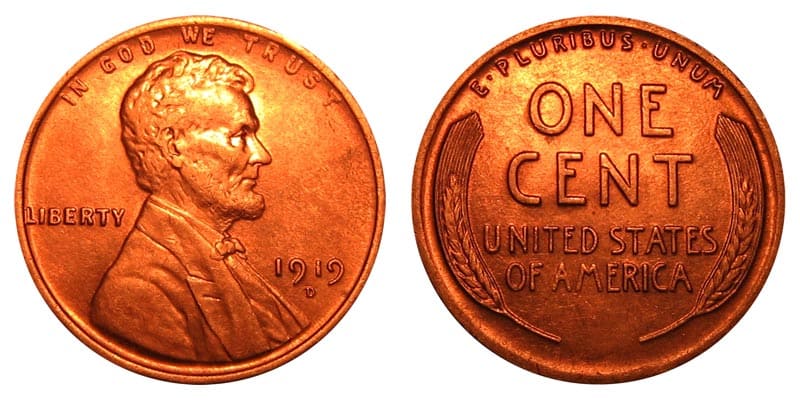
- Mint: Denver
- Designer: Victor D. Brenner
- Mintage: 57,154,000
- Composition: 95% copper and 5% zinc and tin
- Mass: 3.11 grams (0.1097 ounces)
- Face value: 0.01 (one cent)
- Diameter: 19mm (0.74803 inches)
- Shape: Round
- Edge: Plain
- Category: Wheat Lincoln Penny
- Mint Mark: D
The Denver mint had the lowest mintage number, which might make you think they are valuable. However, most of these coins circulated and are damaged, resulting in low prices. The circulated 1919 D Wheat penny has almost no value.
It would be best to focus on the rare specimens with specific defects and red toning. Of course, the condition is a significant factor in determining the value, so even if the coin has a defect but is in bad condition, you cannot get a large amount for it.
So, watch out for the red tone, although those pieces with brown or red-brown tones can also cost a couple of hundred. The 1919 D Wheat penny with brown tone in MS 63 costs $85 to $102, while the pieces with red-brown toning in the same MS 63 can cost $125 to $160.
The most valuable is the 1919 D Wheat penny with red tones- for such a specimen, expect to pay from $3,000 to $35,000, depending on the condition. The ones in MS 66 cost can cost from $3,000 to $5,000, while those pieces with the highest MS 67 cost from $29,000 to $35,000.
Also Read: Top 20 Most Valuable Old Pennies Worth Money (Penny Collection)
1919 Wheat Penny History
The first Lincoln Wheat pennies appeared in 1909 and remained in circulation until 1958. The following year, the reverse was changed-it featured the Lincoln Memorial to commemorate the 150th Lincoln’s birth anniversary.
The history behind the production of the 1919 Lincoln penny is fascinating because the coin US rarely depicted real persons; it was more of a practice tied to the British, which Americans rejected.
However, the president at the time, Theodore Roosevelt, wanted to pay homage to the 16th president, Lincoln, who, in his eyes, was the savior of the Union and also viewed himself as the successor of Lincoln’s political ideas.
Then, Roosevelt learned about the talented designer Brenner, who had already designed a penny with Lincoln’s image. The production began in 1919. However, there was a major issue- the first coin series had large initials, and the US Mint soon removed them.
Later, the Mint incorporated the designer’s initials along Lincoln’s shoulder truncation (VDB), especially on the 1919 Wheat penny.
Even though these coins are not quite a rarity and can be purchased on E-bay, some varieties and dates of Lincoln pennies in the series are highly valuable, such as the 1914 D Lincoln Wheat penny and 1922 plain Lincoln Wheat Penny.
